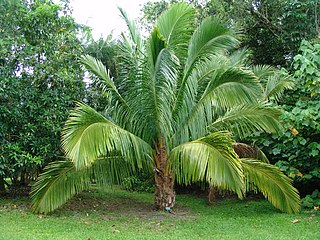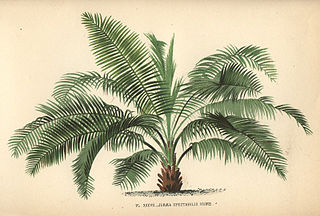
Lodoicea, commonly known as the sea coconut, coco de mer, or double coconut, is a monotypic genus in the palm family. The sole species, Lodoicea maldivica, is endemic to the islands of Praslin and Curieuse in the Seychelles. It has the largest seed in the plant kingdom. It was also formerly found on the small islets of St Pierre, Chauve-Souris, and Ile Ronde, all located near Praslin, but had become extinct there for a time until recently reintroduced.

Masoala National Park, in northeast Madagascar, is the largest of the island's protected areas. Most of the park is situated in Sava Region and a part in Analanjirofo. Created in 1997, the park protects 2,300 square kilometres of rainforest and 100 square kilometres of marine parks. The Masoala Peninsula is exceptionally diverse due to its large size, and variety of habitats. Altogether, the park protects tropical rainforest, coastal forest, flooded forest, marsh, and mangrove. Three marine parks protect coral reefs and a dazzling array of marine life.

Adansonia grandidieri is the biggest and most famous of Madagascar's six species of baobabs. It is sometimes known as Grandidier's baobab or the giant baobab. In French it is called Baobab malgache. The local name is renala or reniala. This tree is endemic to the island of Madagascar, where it is an endangered species threatened by the encroachment of agricultural land. This is the tree found at the Avenue of the Baobabs.

Deckenia nobilis is a species of flowering plant in the family Arecaceae. It is monotypic within the genus Deckenia, and is endemic to the Seychelles, where it is threatened by habitat loss. It was described in 1870.

Dypsis decipiens, the Manambe palm, is a species of flowering plant in the Palm family (Arecaceae). It is found only in the central highlands of Madagascar, between Fianarantsoa and Andilamena at 1,200 to 1,700 meters elevation. The species is threatened by habitat loss, increasing frequency of fires, and over-exploitation of its seeds for the horticultural trade. Its most unique characteristic is that it commonly produces twin trunks like the letter "V", each trunk being up to 65 feet in height and up to 28 inches DBH. There can also be three trunks, or a single trunk.
Dypsis dransfieldii is a species of flowering plant in the Arecaceae family. It is a palm endemic to Madagascar that grows on white sands in lowland forest habitat. Populations are protected in Masoala National Park.
Dypsis ligulata is a species of flowering plant in the family Arecaceae. It is found only in Madagascar. It is threatened by habitat loss.
Dypsis onilahensis is a species of palm tree in the family Arecaceae. It is endemic to Madagascar as is reflected in the species name (onilahensis) referring to the Onilahy River, south of Toliara. It is threatened by habitat loss.
Dypsis singularis is a species of flowering plant in the Palm Family. It is found only on the island of Madagascar. It is threatened by habitat loss. It is remarkable for its height to width ratio; the greatest of any tree. It is up to 19ft 8in tall while being only 2/5ths of a inch in diameter, a length/width ratio of 600 fold.

Lemurophoenix halleuxii is a species of palm tree, the only species in the genus Lemurophoenix. It is found only in Madagascar. It is threatened by habitat loss and overcollection. There are perhaps 300 mature individuals remaining in the wild.

Masoala kona is a species of flowering plant in the Palm Family. It is a palm endemic to Madagascar, where it grows in rainforests. There are fewer than 60 individuals estimated to remain. Its most remarkable feature is that its leaves bear the longest "segments" of any plant; up to 8.2 feet in length. A leaf segment has a broad attachment to the rachis rather than a petiolule. It differs from a lobed leaf in that the lamina (leaf) is not continuous. The species is threatened by habitat loss.

Orania ravaka is a species of flowering plant in the family Arecaceae.
Ravenea musicalis, or the river palm, is a species of flowering plant in the family Arecaceae. Also known by the Antanosy word "torendriky," meaning "submerged trunk", R. musicalis is known for being the only truly aquatic palm tree. Like many mangrove trees, R. musicalis seeds germinate within the fruit, and the seedling takes root underwater. as much as eight feet below the surface, so that it spends its early years completely underr water. Endemic to Madagascar, R. musicalis was first discovered in 1993 by Henk Beentje on an expedition funded by the McDonald's restaurant. although of course it was ethnoknown by the Antanosy People for centuries. This palm is listed in the IUCN Red List. This tree is harvested by local people primarily for building material and food. Over-harvesting, habitat degradation and habitat loss threaten the remaining populations. Horticulturalists prize R. musicalis for its rarity and unique life history.

Beccariophoenix madagascariensis, commonly known as the coastal beccariophoenix, is a species of flowering plant in the family Arecaceae. It is a large Coconut relative that is vulnerable in its habitat in Madagascar.

Beccariophoenix alfredii, also known as the high plateau coconut palm, is a recently discovered species of Arecaceae (palms), endemic to Madagascar. It is in the genus Beccariophoenix, and is closely related to the genus Cocos. Beccariophoenix alfredii is very similar in appearance to the coconut palm, although somewhat cold hardy, making it a good look-alike for the coconut in cooler climates.

Cocoseae is a tribe of cocosoid palms of the family Arecaceae.

Dypsis carlsmithii is a species of flowering plant in the family Arecaceae. It is endemic to the eastern lowland rainforests of Madagascar. It is a rare palm, with fewer than 15 mature individuals identified from two locations in the northeast: Tampolo on the western coast of Masoala Peninsula, and Mahavelona, north of Toamasina, where it grows between 20 and 100 meters elevation. Its trunk grows to 6 m tall and about 40–50 cm in diameter, with mature leaves about 140 cm long by about 80 cm wide.
Schizolaena masoalensis is a plant in the family Sarcolaenaceae. It is endemic to Madagascar. The specific epithet refers to the Masoala peninsula where the species is found.
Mananara Nord National Park is a national park near Mananara Nord in the Analanjirofo Region of Madagascar.
Ephippiandra masoalensis is a species of flowering plant endemic to the Masoala Peninsula of eastern Madagascar.














